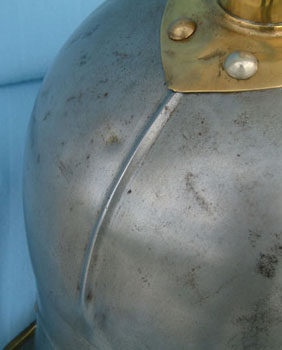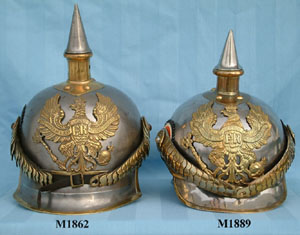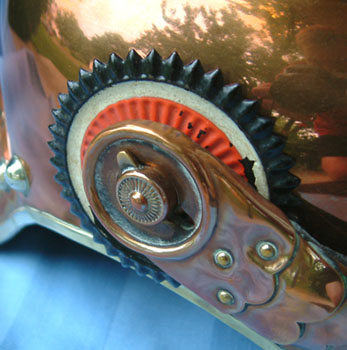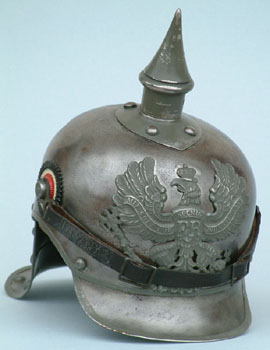|
Kürassier (Heavy Cavalry)
Metalhelme 1843 - 1915 |
| The distinctive steel helmets of the Preußen Kürassier and the Sachsen (Saxon) Schweres Reiter first appeared in 1843 for the Preußen Kürassier, replacing the tall leather helmet that was worn up to that time. The M1843 Metalhelme (a helmet made from polished steel or Tombak) was large and heavy with a pronounced stepped-brim over the forehead and a distinctive "lobster tail" neck guard, both of which served to protect the wearer from sword blows. |
The helmets were made from polished steel with brass fittings, or Tombak (an alloy made from a combination of copper and zinc) with German silver fittings.Convex brass chinscales were worn by all ranks and were secured to the helmet with a 3cm threaded bolt with a brass head. The chinscales did not hook together and required the use of the small leather strap behind the chinscales to keep them together when not worn under the chin.
The line eagle Wappen (front plate) measured 125mm and carried a "FR" on the eagle's chest for most Regiments, except Leib-Kürassier-Regt. Großer Kurfürst who used the old Brandenburg eagle Wappen. For further details on the uniforms worn by all Regiments, please see the "Uniform Details for all Kürassier Regiments" at the top or bottom of this page. |  |
|
| The majority of Kürassier regiments wore polished steel helmets with gilt fittings. The following Regiments wore Tombak helmets with silver fittings with the exception of the chinscales, which were also Tombak: |
- Regt. der Gardes du Corps;
- Garde-Kürassier-Regiment; and
- Kürassier-Regiment Kaiser Nikolas I. von Rußland (Brandenburgisches) Nr.6;
- Kgl.Sächs (Saxon) Garde-Reiter and Kgl.Sächs. Karabiner-Regiment in 1876. Prior to this date, Sachsen (Saxon) Garde-Reiter wore a M1867 leather Raupenhelm.
|
| |
1853 - 1860
In 1853 the long threaded bolts for securing the chinscales were replaced by threaded screws and the new chinscales hooked together in the center with a small ball and corresponding hole when not worn under the chin. In 1860 a Bandeau was added to the Wappen with the motto "MIT GOTT FÜR KOENIG UND VATERLAND" (With God For King And Fatherland). Older plates that were void of the Bandeau, were modified by having a Bandeau soldered to the front to make the plates comply with the regulations. |
| From 1843 to 1860 the Garde du Corps and Garde Kürassier wore a large silver Garde pattern Wappen on the helmet, adding the date "1860" in that year. Please see Kürassier Plate 1 for an illustration of the various helmet Wappen. |
1862 - 1867
Further modifications in 1862 reduced the Kürassier Metalhelme shell and spike in height by approx. 2 cm, the front and rear visors were reduced somewhat in length, and the width of the trim around the front and rear visors was reduced from 8 mm to 5 mm. These modifications resulted in the M1862 Metalhelme. The example shown here is an issued Model 1862 Mannschaften (Other Ranks) Kürassier Metalhelme which has the 1853 threaded screw posts, curved brass chinscales, and the distinctive raw metal edge between the front and rear visors. In 1867 a small strip of brass or German silver dependant upon the Regiment, was placed along the bottom of the helmet joining the front and rear visors and the overall shape of the helmet was reduced slightly in size. This modification became the M1867 Metalhelme.
|
 Click to Enlarge
|
|
 Click to Enlarge
| Like the M1843 Metalhelme, the liner of the issued M1862 Metalhelme was of heavy leather with rounded "tongues" perforated at the ends for a leather string to adjust the fit. Contrary to some publications, this liner was in use for issue helmets for the entire life of the Metalhelme from 1843 to 1915. The liner was secured at the sides with the posts of the chinscales, and at the front and rear by spilt brads which passed through the liner and the helmet shell.
|
|
1889
In 1889 the Preußen Kürassier Mannschaften (Other Ranks) Metalhelme received a rounded front visor and was reduced in height and volume to make it less cumbersome. Like most helmets, this helmet was updated in 1897 with a Reichs Kokarde. Note the threaded screw-posts for the chinscales that were utilized prior to 1894. Note that like all helmets, this example was updated in 1897 with the new Reich's Kokarde, worn on the right side of the Metalhelme.
|
 Click to Enlarge
|
|
 | This photo shows the raised ridge reinforcement carried on all issued Metalhelme until 1889. After this date, only officer Metalhelme retained the ridge to strengthen the shell, however, this option was available on Eigentums-helm, (also known as Extra-helm or Eigetumsstück) which were Metalhelme that were privately purchased by an individual. |
|
| A comparison of the front of the M1862 to a M1889. Note the stepped visor on the M1862 was replaced by a rounded visor in 1889. Also note the dramatic difference in height.
|
 Click to Enlarge
|
|
 Click to Enlarge
| A comparison of the M1862 to a M1889. The massive size of the M1862 compared to the M1889 is evident in this photograph. Both these helmets are approximately a size 56. On M1862 helmets and prior, the space between front and rear visors is blank as this photo illustrates. In 1867, the brass or silver trim that went around the visors, was placed along this blank spot.
|
|
1894/1897
In 1894 the Preußen Kürassier Mannschaften (Other Ranks) Metalhelme received the Model 1891 posts for chinscales to replace the threaded screw-posts. At 36mm, the M91 pattern chinscales on M94 Metalhelme are considerably wider at their widest point compared to standard Artillery, Train, and other Cavalry rounded chinscales which are only 25mm wide at the widest point.
In 1897 the all helmets were updated with the new Reich's Kokarde, worn on the right side of the Metalhelme; and the State Kokarden was moved to the left side of the helmet. |  |
|
 Click to Enlarge
| The Regt. der Gardes du Corps and the Garde-Kürassier-Regiment were the only two Regiments entitled to wear a removable eagle on parade. On all other occasions, a spike was worn. The parade eagle was mounted to the skull of the helmet with a large oval brass nut and threaded bolt which was soldered to the eagle base. This example is a Model 1894 Preußen Kürassier Mannschaft (Other Ranks) Metalhelme to parade for the Garde Kürassier Regt., Berlin Garde - Korps. The helmet is manufactured from Tombak with German silver fittings. This example carries the removable M91 chinscales, also in Tombak.
|
|
Sachsen (Saxon) Schweres Reiter
The Sachsen (Saxon) Schweres Reiter were entitled to wear a removable lion on parade after 1876, when the four Reiter regiments were reorganized. Two Regiments were equipped with Tombak Metallhelme: Kgl.Sächs. Garde-Reiter-Regiment (which retained its name), and Sachsen Reiter Regt N. 3 which was named Kgl.Sächs. Karabiner-Regiment. Sachsen Reiter Regts 1 & 2 became Kgl. Sächs. Husaren-Regts Nr.18 & 19 and were equipped with Pelzmützen (Busbies). |
 Photo used with the kind permission of Brian Hilderman | Officer's wore a cloverleaf spike base with officer Kokarden while the Mannschaften (Other Ranks) wore a "football" shaped base with Mannschaften Kokarden. When the Mannschaften helmet changed from a stepped-visors in 1889, officer Metalhelme retained the stepped visor. Officer Metalhelme also have finer edging around the circumference of the helmet, and utilized the "squared finger" liners until 1880 when the internal sweatband and skull-cap came into use.
On 15 May 1899 the shape of the Kürassier officer's helmet was changed to the final and more elegant appearance with a domed skull and longer neck. This photograph shows Artur von Klingspor; (1878-1904) Kürassier-Regt. von Seydlitz (4.Magdeburgisches) Nr.7 wearing an officer's M1889/99. |
|
1915
In accordance with the 1915 regulations steel helmets no longer would use brass, silver, or Tombak. Preußen Kürassier (Other Ranks) Metalhelme were steel with grey oxidized steel fittings for all Regiments and the brass or Tombak chinscales were replaced with a M91 leather chinstrap.
Notice that the Model 1915 helmets still retained the unique 'football' shaped spike base and Kürassier pattern spike.
|
 Click to Enlarge
|
|
 |
| |
Kokarden
Shown above are three of the different patterns of Preußen (Prussian) Kokarden worn on the Mannschaften (Other Ranks) Metalhelme.
From 1843 to 1857 the Kokarde was made of painted leather, or wool. In 1857 the stamped metal Kokarde was introduced which measured an impressive 73 mm. In 1860 the size was reduced to 63 mm, which can be found with both the small-hole (pre-1891) and with the larger hole for the M1891 chinscale mount. Model 1915 Metalhelme are found with both the large 63 mm M1891 Metalhelme Kokarde and the standard M1891 Pickelhaube pattern Kokarde. |
| |
|
| |
 |
| |












